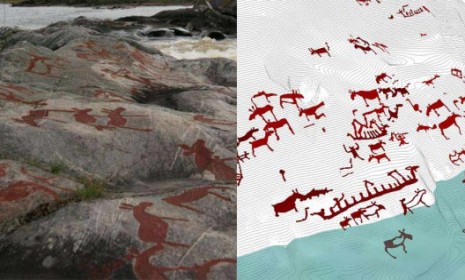Discovered: Facebook... for cavemen?
Cambridge University archaeologists make the case that a primitive form of social media was surprisingly similar to the high-tech platforms we use today

Before Facebook, MySpace, or even Friendster, humans had... rock-etched status updates? Archaeologists from Cambridge are currently analyzing a "prehistoric version of Facebook," which, they argue, is one of the earliest examples of social networking on record. Here, a concise guide:
What is it they're studying, exactly?
Researchers are analyzing thousands of images strangely left on soccer-field-sized rock faces at two archaeological sites in Sweden and Russia. The etchings were found alongside river networks, where Bronze Age tribes would return year after year to add new images of animals, people, boats, hunting scenes, and mythological depictions of centaurs and mermaids. The site gave "different clans the opportunity to build up knowledge and share tips on hunting and other necessities for survival," says Britain's Daily Mail. Some of the earliest artwork dates back 6,000 years.
The Week
Escape your echo chamber. Get the facts behind the news, plus analysis from multiple perspectives.

Sign up for The Week's Free Newsletters
From our morning news briefing to a weekly Good News Newsletter, get the best of The Week delivered directly to your inbox.
From our morning news briefing to a weekly Good News Newsletter, get the best of The Week delivered directly to your inbox.
How does this constitute social networking?
Archaeologists like Cambridge's Mark Sapwell think the primitive canvases possessed the same fundamental characteristics as a modern day Facebook wall. "People would create art as an open invitation," Sapwell tells PhysOrg. "Like a Facebook status invites comment, the rock art appears very social and invites addition." Over hundreds or even thousands of years, new images were added, evolving dialectically as a sort of early comment system. Tribesman even bestowed their stamps of approval on drawings they appreciated — an instinctive, early form of the "like," says Sapwell.
How did these "status updates" change over time?
The earliest depictions mainly featured animals like elk. As time went on, new ideas began to take shape: Centaurs and other imaginative hybrids, followed by depictions of boats and travel. A few pictographs would eventually appear in "mobile" form as inscriptions on pots and knives, says IT Portal.
A free daily email with the biggest news stories of the day – and the best features from TheWeek.com
Why does this matter?
The social networking comparison, while arguably tenuous, speaks to a basic, fundamental need to communicate. "I think people went [to these places] because they knew people had been there before them," says Sapwell. As Facebook's popularity demonstrates, "people have always wanted to feel connected to each other." These rough, early forms of media served as an "expression of identity for these very early societies."
Sources: The Awl, Daily Mail, IT Portal, Metro, PhysOrg
-
 Political cartoons for December 20
Political cartoons for December 20Cartoons Saturday’s political cartoons include drowning rats, the ACA, and more
-
 5 fairly vain cartoons about Vanity Fair’s interviews with Susie Wiles
5 fairly vain cartoons about Vanity Fair’s interviews with Susie WilesCartoon Artists take on demolition derby, alcoholic personality, and more
-
 Joanna Trollope: novelist who had a No. 1 bestseller with The Rector’s Wife
Joanna Trollope: novelist who had a No. 1 bestseller with The Rector’s WifeIn the Spotlight Trollope found fame with intelligent novels about the dramas and dilemmas of modern women